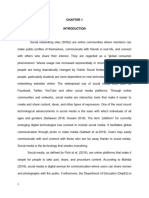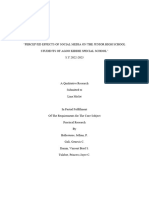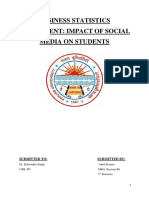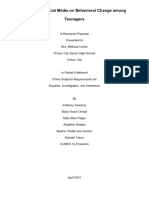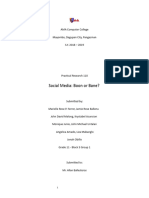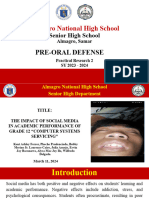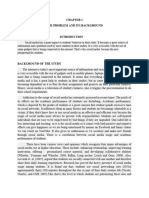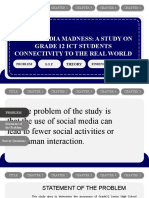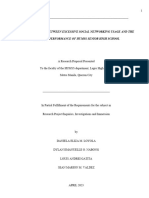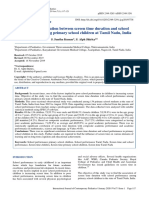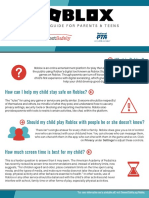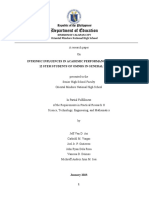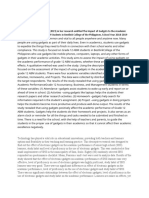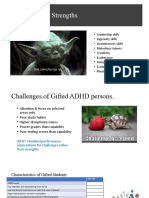The Impact of Social Media on the Computer Use Habits of Grade 11 Student at BNHS
CHAPTER 1
Background of the Study
Social media encompasses web-based applications that facilitate interactive content sharing,
collaboration, and networking (Kaplan & Haenlein, 2010). Initially, social networking sites like MySpace
and Friendster emerged in the early 2000s, but modern platforms have evolved to offer diverse
functionalities, including instant messaging, video streaming, and e-commerce integration (Kietzmann et
al., 2011). The growth of mobile technology and artificial intelligence has further enhanced social
media's influence, making it a primary mode of communication and information dissemination.
Social media has become an important part of modern life, impacting communication, business,
education, and interpersonal relationships. The emergence of networks like Facebook, Twitter (X),
Instagram, LinkedIn, and TikTok has revolutionized global information engagement and interpersonal
interaction.
The rise of social media has significantly impacted computer habits, including screen time, multitasking,
productivity, cybersecurity, and mental well-being. Excessive screen time can lead to digital eye strain,
sleep disturbances, and reduced physical activity. Multitasking can negatively impact productivity, as
users keep tabs open while working or studying, leading to frequent distractions. Online communication
habits have changed, with instant messaging, video calls, and chats replacing traditional methods.
Cybersecurity risks have also increased, as users share personal information online, making them
vulnerable to cyberattacks. Mental well-being can be affected by constant exposure to curated content,
social comparison, anxiety, and self-esteem issues, and the addictive nature of social media can result in
compulsive behavior.
Research on teenagers' use of social media has identified both positive and negative impacts. A study
published in Computers in Human Behavior found that social media can enhance communication skills
and social engagement among adolescents. However, the same study also highlighted potential
drawbacks, such as academic distractions and mental health concerns, including "Facebook depression."
The researchers emphasized the importance of parental guidance and monitoring to encourage healthy
social media usage patterns among teenagers
Statement of the Problem
The use of social media has become a prevalent part of daily life, especially among teenagers, including
Grade 11 students at BNHS. While social media platforms provide opportunities for communication,
�social interaction, and information sharing, there is growing concern regarding their impact on students'
computer use habits. The increasing screen time, multitasking behaviors, and the shift in communication
methods may be affecting students' productivity, academic performance, mental well-being, and overall
computer usage patterns.
This study will look into the following questions:
1. How many hours do you typically spend using a computer each day?
2. What social media platforms do you use the most when using a computer?
3. How much of your computer time is spent on social media compared to academic activities?
4. Do you use social media for educational purposes, such a research or schoolwork?
5. How has social media influenced your time management when using a computer for schoolwork?
By addressing these issues, the study aims to provide insights into how social media affects the
computer use habits of Grade 11 students, contributing to a better understanding of the balance
between social media engagement and its potential negative consequences.
Scope and Delimitation
Scope:
This study will focus on Grade 11 TVL (Technical-Vocational-Livelihood) students at BNHS and explore
how social media influences their computer use habits, particularly for school-related activities. The
following aspects will be included in the study:
1. Participants: The study will involve Grade 11 TVL students at BNHS, who will be asked to share their
experiences and habits regarding social media and computer use.
2. Social Media Platforms: The study will focus on the most commonly used social media platforms
among the students, such as Facebook, Instagram, Twitter (X), TikTok, and others. The research will
explore how these platforms impact the way students use computers.
3. Time Spent on Computers: The research will examine how many hours students spend using
computers each day. It will also look at how much of that time is spent on social media compared to
schoolwork or academic activities.
4. Academic vs. Non-Academic Use: The study will investigate how students divide their computer time
between social media and academic tasks, like research, assignments, or studying.
5. Time Management: The study will explore how social media usage affects students’ time
management, especially when using computers for schoolwork.
Delimitation:
1. Limited to Grade 11 TVL Students at BNHS: The study will be conducted only among Grade 11 TVL
students at BNHS, so the results may not apply to students from other grade levels or schools.
�2. Focus on Computer Use: The study will only examine how students use computers for social media
and academic tasks. It will not include smartphones, tablets, or other devices, even though they may
also be used for social media.
3. Time Frame: The study will be conducted over a specific period, which may limit the ability to observe
long-term changes in students' social media and computer use habits.
4. Self-Reported Data: The data will be collected from students' self-reports, which could be influenced
by personal biases or inaccurate recall of how much time is spent on social media or school-related
tasks.
Importance of the Study
This study is important because it will help us understand how social media affects the computer use
habits of Grade 11 TVL students at BNHS. Social media is a big part of students' daily lives, and it is
important to see how it influences their schoolwork and focus. By looking at how much time students
spend on social media compared to school tasks, the study will help teachers, parents, and school
officials come up with ways to help students use their computers in a more balanced and productive
way.
This study will also highlight how social media might impact students' mental health and well-being. It
could show if too much time online affects students' mood, physical health, or ability to concentrate. By
understanding these impacts, we can find ways to encourage healthy social media habits while
supporting students' learning and personal development.
In the long run, the findings could help schools and communities create better strategies for managing
social media use among students, making sure that technology supports both their education and
overall health.
Defination of Terms
1. Cybersecurity
The practice of protecting computers, networks, and online data from unauthorized access, attacks, or
damage. The study explores how students' online behaviors, especially on social media, may expose
them to potential cybersecurity risks.
2. Digital Eye Strain
A physical condition caused by prolonged screen use, leading to symptoms such as dry eyes, blurred
vision, headaches, and fatigue. This term is relevant to the study in terms of the potential negative
effects of excessive screen time on students’ health.
3. Multitasking
The practice of engaging in more than one activity at a time. For example, students may simultaneously
chat on social media while working on homework or conducting research. Multitasking can impact the
quality and focus of academic work.
�4. Mental Well-being
The emotional, psychological, and social aspects of a person’s life, which can be influenced by various
factors, including online interactions. This term is important in understanding how excessive social
media use can affect students' moods, self-esteem, anxiety, and overall mental health.
5. Facebook Depression
A term describing the negative emotional effects that can arise from prolonged social media use,
particularly on platforms like Facebook. The study considers this term in relation to how students may
experience negative emotions, such as loneliness or inadequacy, from social media interactions.
6. Non-Academic Activities
Tasks or actions that are not related to schoolwork, such as social media use, gaming, browsing the
internet for entertainment, or any other form of digital activity that does not contribute to academic
learning.
7. Computer Use Habits
The patterns, behaviors, and frequency with which individuals use computers for various tasks, including
academic activities, social media engagement, entertainment, or other online activities. This includes
the time spent on the computer and how it is allocated between different tasks.
8. Social Media Platforms
Specific websites or applications that host social media activities. In this study, the most common
platforms include Facebook, Instagram, Twitter (X), and TikTok. These platforms allow for
communication, entertainment, and information sharing.
